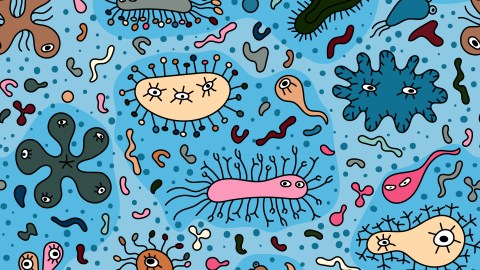The ocean is teeming with viruses — billions and billions of them

Shutterstock
- New research suggests that there are nearly 200,000 different viral populations in the ocean.
- Surprisingly, the Arctic appears to be a viral hotspot.
- Viruses play an important role in the ocean’s food chain and carbon cycle, making research such as this potentially valuable to future climate change work.
Bad news for thalassophobes; there’s more than just sharks and giant squids lurking beneath the ocean’s surface. New research published in Cell found that there are nearly 200,000 different viral populations swimming about the seas, and they tend to gather in some unexpected places, too.
What is a viral population?
Generally, scientists don’t classify viruses into species since they evolve so quickly and because viruses aren’t truly “alive,” at least not in the biological sense. Instead, viruses are more readily classified into populations, or groups of discrete genetic lineages. So, 200,000 viral populations doesn’t refer to 200,000 individual viruses; there’s far more than that in the oceans. Even just a liter of seawater contains an estimated 100 billion individual viruses.
Not much work had been done on estimating the number of viral populations out there, especially not in the ocean. Using data collected by the Tara Oceans research vessel, this new study identified 12 times as many viral populations as previous research. To do so, the research team analyzed over 180 samples across the globe between 2009 and 2013.
What did they find?
This research identified some interesting features of the global distribution of viral populations in the ocean. First, they found five ecological zones across the planet’s oceans where different populations of viruses tend to cluster: the Arctic; the Antarctic; and the temperate and tropical epipelagic, the mesopelagic, and the bathypelagic. These last three zones correspond to depths of 0–150 meters, 150–1,000 meters, and deeper than 2,000 meters, respectively. Furthermore, the researchers discovered that different populations of viruses grouped together depending upon a zone’s temperature, the reason being that their hosts — microbial life — thrived at different temperatures.
The temperate and tropical epipelagic zone was shown to be something of a viral hotspot. This area had significantly more diversity in its viral populations than other areas. Surprisingly, the Arctic also had highly diverse viral populations. This is in contrast to the pattern found for larger organisms; diversity tends to be highest at the equator and then diminish as you move closer to the poles.
These two zones, too, seemed to have exclusive populations of viruses — that is, the virus populations found in these hotspots didn’t appear elsewhere. In contrast, the Antarctic and bathypelagic zones contained viruses that were often found in other zones, suggesting that more viruses were migrating to these areas from elsewhere than were reproducing in these zones.
The importance of the study
In many ways, viruses shape the entire food chain. The vast majority of life in the oceans consists of microbial life, which in turn act as nutrient sources for many plants and animals in the oceans. Viruses primarily prey upon these microbes and shape their populations, making it critical to understand how many viral groups there are, how diverse they are, and where we can find them.
But this research could be turned to an even more practical use. In an interview with CNN, microbiologist and study author Matthew Sullivan claims that this knowledge “helps us do a lot of the things we’d be interested in to better understand the ocean and, I hate to say it, but maybe to have to engineer the ocean at some point to combat climate change.”
Sullivan suggested that by manipulating viral genomes, we could encourage viruses to suck up carbon dioxide in the air for sequestration deep beneath the ocean’s surface. But before this and related work can be done, scientists need to have a solid understanding of the diversity and distribution of our ocean’s viruses.





